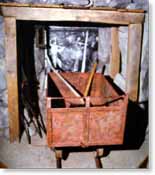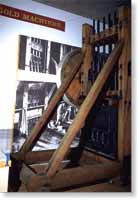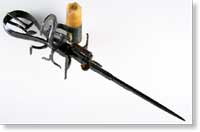Giant Gold Machines - Hard Rock Mining Much of the Sierra Nevada's gold is encased in
quartz veins deep within the mountains. To reach these veins of gold-bearing quartz, hard
rock miners tunneled and sank shafts deep into mountainsides. Imagine what it was like to
work thousands of feet below the surface. Thousands of miles of tunnels were dug beneath
the mountains and shored up with Sierran timber. Miners blasted and dug their way through
the mountains, and descended in mine cars, cage-like elevators, to fill buckets and ore
cars with quartz rock. This was dangerous work: cave-ins, explosions, toxic fumes, and
flooding injured and killed many. Much of the Sierra Nevada's gold is encased in
quartz veins deep within the mountains. To reach these veins of gold-bearing quartz, hard
rock miners tunneled and sank shafts deep into mountainsides. Imagine what it was like to
work thousands of feet below the surface. Thousands of miles of tunnels were dug beneath
the mountains and shored up with Sierran timber. Miners blasted and dug their way through
the mountains, and descended in mine cars, cage-like elevators, to fill buckets and ore
cars with quartz rock. This was dangerous work: cave-ins, explosions, toxic fumes, and
flooding injured and killed many.

Click here to see the Original
Sixteen to One Mine

Click here to see
the Empire Mine
 Hard
rock miners had to mill, or crush the quartz ore. They worked stamp mills to pulverize the
ore to a powder. Early stamp mills had two to five stamps. Later, banks of forty or more
were used. Gold was then separated from this fine powder by the use of mercury, or
quicksilver as it was called. Despite the efforts of miners to recover their valuable
mercury, tons of mercury were being washed down from the mountains. Mercury is very toxic,
especially when heated to a vapor, or incorporated into the food chain. Fish and wildlife
deaths from the release of mercury and other toxic mining Hard
rock miners had to mill, or crush the quartz ore. They worked stamp mills to pulverize the
ore to a powder. Early stamp mills had two to five stamps. Later, banks of forty or more
were used. Gold was then separated from this fine powder by the use of mercury, or
quicksilver as it was called. Despite the efforts of miners to recover their valuable
mercury, tons of mercury were being washed down from the mountains. Mercury is very toxic,
especially when heated to a vapor, or incorporated into the food chain. Fish and wildlife
deaths from the release of mercury and other toxic mining discharges were common. Large quantities of mercury still remain in the sediment layers of
the rivers and in San Francisco Bay, a toxic legacy of our mining heritage.
discharges were common. Large quantities of mercury still remain in the sediment layers of
the rivers and in San Francisco Bay, a toxic legacy of our mining heritage.
Top: Stamp Mill, Photo by Christopher Richard
Middle: Hard Rock Platform, Photo by Christopher Richard
Bottom: Commemerative Mining Pick and Candle, Collection of the Oakland Museum of
California
Dredge | Hard
Rock | Hydralic |